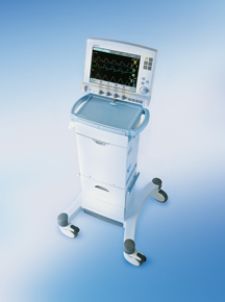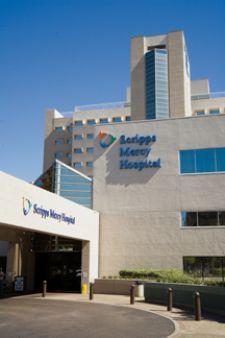
Scripps Mercy Hospital, San Diego, CA
Providing excellent patient care is a top priority for Scripps Mercy Hospital, the longest-operating hospital in San Diego, CA. It has served the communities of San Diego and Chula Vista for 113 years, and last year the hospital treated more than 50,000 ER patients and 2,200 trauma patients. With a total of 32 intensive-care beds, it is among the top hospitals for cancer and cardiac care as well as bariatric surgery. To ensure state-of-the-art care in its respiratory services, Scripps Mercy recently replaced its entire fleet of ventilators with MAQUET’S SERVO-i ventilators equipped with BiVent.
BiVent is an effective mode of mechanical ventilation similar to Airway Pressure Release Ventilation (APRV), but with additional features. BiVent applies Continuous Positive Airway Pressure (CPAP) to maintain adequate lung volume and promote alveolar recruitment. It also adds a time-cycled release phase to lower set pressure (P-low). In addition, spontaneous breathing can be integrated and is independent of the ventilator cycle.
“Spontaneous breaths at the P-high improves dependent ventilation through pleural pressure changes, rather than the application of additional applied airway pressure,” explained Jodi Brewer, RCP, RRT, an educator and clinical respiratory specialist in the Respiratory Therapy Department at Scripps. “The advantage is the recruited lung requires less pressure than the recruiting lung.”
Leading-Edge Respiratory Care
“Since the arrival of these ventilators,” said Stephen Kaminski, M.D., FACS, a leading trauma service physician at Scripps Mercy, “we have been able to advance our ventilator care and our lung management to match state-of-the-art information.”
Dr. Kaminski, who, during his fellowship was trained on APRV, has noticed that his trauma patients are more comfortable on BiVent. Because they are able to breathe on their own, they are not “bucking” the respirator as often happens with conventional ventilation, he explains.
In addition, because patients on BiVent breathe spontaneously throughout the ventilatory cycle, the mode requires much less sedation and nearly eliminates paralytics. As a result, Dr. Kaminski has found that patients who are on the mode are often easier to wean and may be able to be weaned sooner, lowering the risk of serious complications that are commonly associated with long-term mechanical ventilation.
Dr. Kaminski uses the BiVent prophylactically on all his trauma patients, and when he introduced it to the five other physicians in his trauma practice, they were eager to incorporate it as well. “They all adapted it with open arms, from our senior docs to our more junior partners,” Dr. Kaminski said.
The Best Mode for Acute-Care Patients
BiVent is now the mode of choice for trauma patients at Scripps Mercy, and is fast becoming the favorite for its critically ill medical/surgical patients.
“It gives us an extra dimension in being able to ventilate our patients, especially the very sick cases,” said Julian Lichter, M.D., who has been medical director of Respiratory Care Services at Scripps Mercy since 2002.
Dr. Lichter says that on several occasions BiVent has proven a lifesaving mode for some patients who are more difficult to ventilate because of their size or other pre-existing health conditions. In difficult cases, BiVent has become standard protocol at the hospital.
“Before we had the BiVent capability, we probably had 20 percent whom we were not able to oxygenate or who oxygenated very poorly,” Dr. Lichter said. “Now, we can oxygenate upwards of 95 percent of patients.”
Dr. Lichter also likes the fact that BiVent and proning can work well together when ventilating difficult patients.
BiVent can also be used in conjunction with pressure support, says Glenn Tanaka, RRT, RCP, Manager of Respiratory Care Services at Scripps Mercy. The SERVO-i allows the judicious addition of pressure support due to its floating exhalation valve, he explains.
“The idea is to use the tools so you don’t have change to an oscillatory ventilation strategy,” Tanaka said. “Thanks to BiVent, we reduced the need for oscillation.”
Physicians, Staff Embrace BiVent
As an educator, Brewer was pleasantly surprised at how well the staff embraced the new mode and other SERVO-i open-lung capabilities.
“To be honest,” she said, “I didn’t expect people to be as enthusiastic as they were because when there is a new theory out there, it is often hard to get everyone thinking it is advantageous.”
However, Brewer says, the respiratory therapists were eager to learn BiVent and to assist the physicians in using it in appropriate cases.
With the support of MAQUET’s clinical applications specialists, a select group of physicians and RTs were trained first and they, in turn, trained others, including the nurses, on the use of BiVent. The company provides continued support as needed. Scripps Mercy believes in collaborative healthcare and thus crosstrains its staff, which was easy to do in this case because the ventilators and BiVent operate with a touchscreen, Tanaka notes. “BiVent is very user-friendly,” he said.
“It is very important that the therapists appreciate the ventilator and are comfortable with all its modes because they are very closely involved with the equipment,”
Dr. Lichter said. The hospital has 70 respiratory therapists on staff.
Tanaka says that like anything new, the physicians and staff had to be convinced that BiVent works, but it did not take long once they saw how easily it could be employed, and how beneficial it could be for their trauma and medical patients.
“Going forward,” Tanaka said, “we want to be able to provide the best care
possible for our patients, and we believe that with BiVent, we can do that.”


